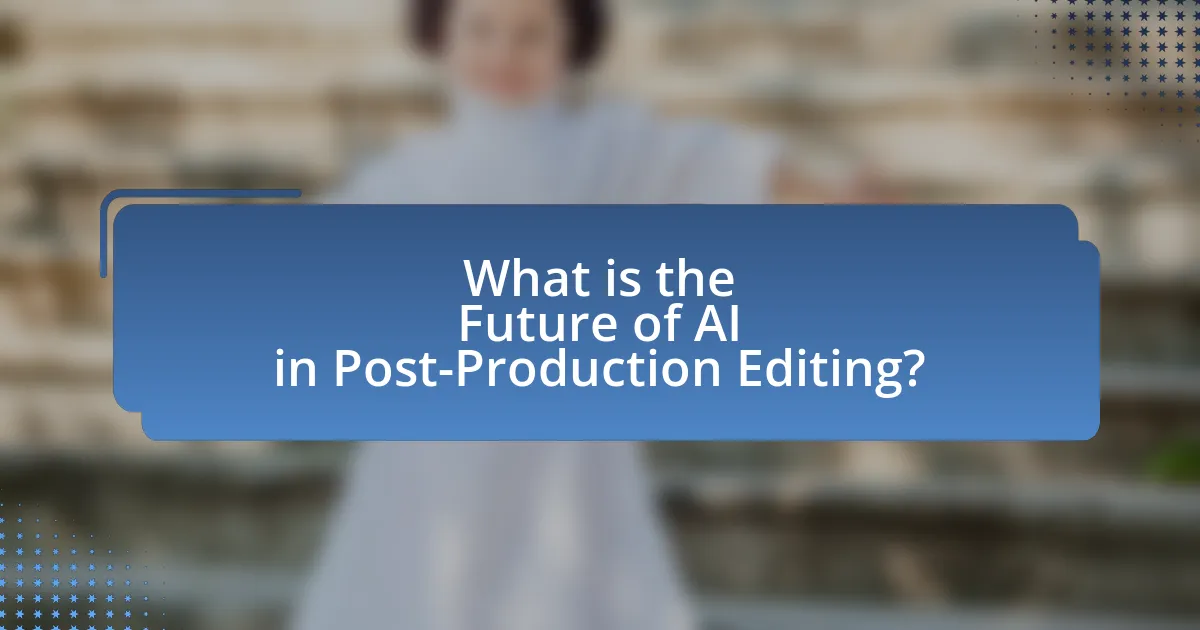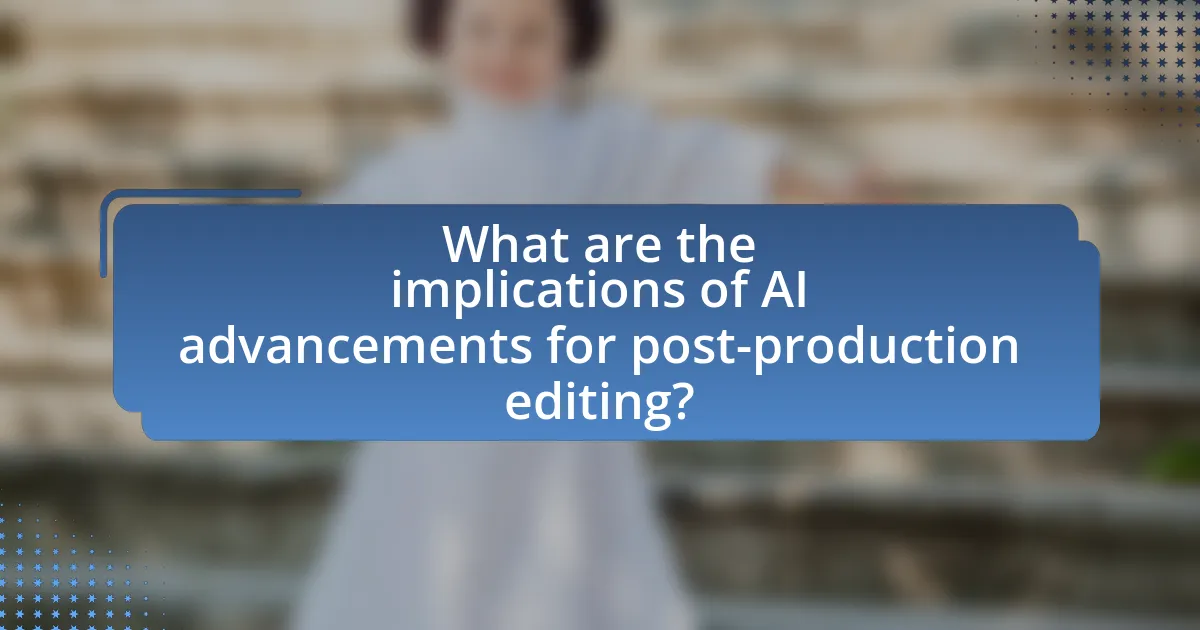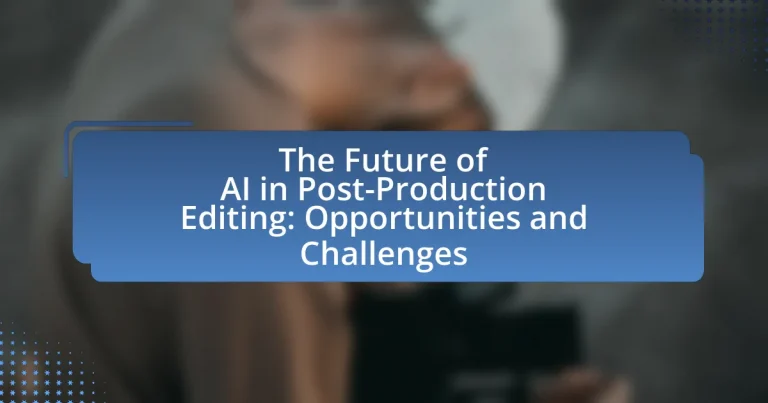The article focuses on the future of artificial intelligence (AI) in post-production editing, highlighting both the opportunities and challenges it presents. It discusses how AI technologies, such as machine learning and computer vision, are being integrated into editing workflows to automate tasks like color correction, audio enhancement, and scene detection, significantly improving efficiency and content quality. The article also addresses the potential impact of AI on job roles within the industry, the ethical considerations surrounding its use, and the skills editors will need to thrive in an AI-enhanced environment. Additionally, it explores future trends and emerging technologies that could further complement AI in post-production.

What is the Future of AI in Post-Production Editing?
The future of AI in post-production editing is characterized by increased automation, enhanced efficiency, and improved creative capabilities. AI technologies, such as machine learning and computer vision, are being integrated into editing software to streamline processes like color correction, audio mixing, and scene detection. For instance, Adobe’s Sensei AI platform automates repetitive tasks, allowing editors to focus on creative decision-making. Additionally, AI can analyze vast amounts of footage quickly, identifying the best takes and suggesting edits based on narrative structure, which significantly reduces editing time. As AI continues to evolve, it is expected to play a pivotal role in shaping the workflows of post-production, enabling editors to produce high-quality content more efficiently while also fostering new creative possibilities.
How is AI currently being utilized in post-production editing?
AI is currently utilized in post-production editing through automated processes such as video editing, color correction, and audio enhancement. These AI-driven tools analyze footage to identify key scenes, suggest edits, and apply consistent color grading, significantly reducing the time and effort required by human editors. For instance, Adobe’s Sensei technology employs machine learning algorithms to streamline workflows, enabling faster turnaround times for projects. Additionally, AI can enhance audio quality by automatically removing background noise and optimizing sound levels, further improving the overall production quality.
What specific tasks can AI automate in the editing process?
AI can automate several specific tasks in the editing process, including video stabilization, color correction, audio enhancement, and scene detection. Video stabilization algorithms analyze footage to reduce shakiness, resulting in smoother visuals. Color correction tools utilize machine learning to adjust color balance and exposure automatically, ensuring consistent visual quality. Audio enhancement features can identify and reduce background noise while optimizing sound levels, improving overall audio clarity. Scene detection algorithms can automatically identify and segment different scenes within a video, streamlining the editing workflow. These capabilities demonstrate AI’s potential to significantly enhance efficiency and quality in post-production editing.
How does AI enhance the efficiency of post-production workflows?
AI enhances the efficiency of post-production workflows by automating repetitive tasks, thereby reducing time and labor costs. For instance, AI algorithms can quickly analyze and categorize footage, allowing editors to locate specific clips faster than manual searching. Additionally, AI-driven tools can assist in color correction, audio enhancement, and visual effects integration, streamlining the overall editing process. According to a study by the International Journal of Information Management, AI can reduce post-production time by up to 30%, demonstrating its significant impact on workflow efficiency.
What are the potential opportunities presented by AI in post-production editing?
AI presents significant opportunities in post-production editing by enhancing efficiency, automating repetitive tasks, and improving content quality. For instance, AI algorithms can analyze footage and suggest edits, drastically reducing the time editors spend on manual tasks. According to a study by the University of Southern California, AI-driven tools can cut editing time by up to 50%, allowing creative professionals to focus on more complex aspects of storytelling. Additionally, AI can assist in color correction, sound editing, and even generating visual effects, leading to a more polished final product. These advancements not only streamline workflows but also enable editors to produce higher-quality content in less time.
How can AI improve the quality of edited content?
AI can improve the quality of edited content by enhancing accuracy, consistency, and efficiency in the editing process. For instance, AI algorithms can analyze text for grammatical errors, stylistic inconsistencies, and adherence to specific guidelines, resulting in a more polished final product. A study by Grammarly found that AI-driven writing assistance can reduce grammatical errors by up to 70%, demonstrating the effectiveness of AI in improving written content quality. Additionally, AI tools can provide real-time feedback and suggestions, allowing editors to make informed decisions quickly, thereby streamlining the editing workflow and ensuring higher quality outcomes.
What new creative possibilities does AI offer to editors?
AI offers editors enhanced creative possibilities through automation, advanced analytics, and personalized content generation. Automation allows editors to streamline repetitive tasks, such as color correction and audio syncing, freeing them to focus on storytelling and artistic choices. Advanced analytics enable editors to analyze audience preferences and engagement metrics, guiding them in crafting content that resonates more effectively. Additionally, AI-driven tools can generate personalized content variations, allowing editors to tailor their work for specific demographics or platforms, thereby increasing viewer engagement. These capabilities are supported by the growing integration of AI technologies in editing software, which has been shown to improve efficiency and creativity in post-production workflows.
What challenges does the integration of AI pose in post-production editing?
The integration of AI in post-production editing poses challenges such as the potential loss of creative control and the need for significant training and adaptation by editors. Creative professionals may find that AI tools, while efficient, can lead to homogenized outputs that lack the unique artistic touch that human editors provide. Additionally, editors must invest time in learning how to effectively use AI technologies, which can disrupt established workflows and require ongoing adjustments to their skill sets. The reliance on AI also raises concerns about data privacy and the ethical implications of using machine learning algorithms that may inadvertently perpetuate biases present in training data.
What are the ethical considerations surrounding AI in editing?
The ethical considerations surrounding AI in editing include issues of authorship, bias, transparency, and the potential for misinformation. Authorship concerns arise as AI-generated content may blur the lines of who is credited for creative work, impacting the rights of original creators. Bias in AI algorithms can lead to the perpetuation of stereotypes or exclusion of diverse perspectives, as seen in studies indicating that AI systems often reflect the biases present in their training data. Transparency is crucial, as users need to understand how AI tools make decisions, which can affect trust in the editing process. Lastly, the potential for misinformation is significant, as AI can manipulate content in ways that mislead audiences, raising questions about accountability and the ethical use of technology in media.
How might AI impact job roles within the post-production industry?
AI is likely to transform job roles within the post-production industry by automating repetitive tasks, enhancing efficiency, and enabling new creative possibilities. For instance, AI-driven tools can streamline video editing processes, such as color correction and audio mixing, which traditionally required extensive manual labor. According to a report by PwC, automation in creative industries could lead to a 30% increase in productivity by 2030. This shift may result in a reallocation of human resources towards more strategic and creative roles, as routine tasks become increasingly handled by AI systems. Consequently, professionals in post-production may need to adapt by acquiring new skills that complement AI technologies, focusing on creative decision-making and advanced technical expertise.
How can the post-production industry prepare for the future of AI?
The post-production industry can prepare for the future of AI by investing in training and upskilling professionals to work alongside AI technologies. As AI tools become more integrated into workflows, understanding how to leverage these tools effectively will be crucial for enhancing productivity and creativity. For instance, a report by PwC indicates that AI could contribute up to $15.7 trillion to the global economy by 2030, highlighting the importance of adapting to technological advancements. Additionally, post-production companies should adopt flexible workflows that incorporate AI-driven solutions for tasks such as editing, color correction, and sound design, allowing for more efficient processes and improved output quality.
What skills will editors need to thrive in an AI-enhanced environment?
Editors will need a combination of technical proficiency, adaptability, and critical thinking skills to thrive in an AI-enhanced environment. Technical proficiency includes understanding AI tools and software that assist in editing processes, such as automated editing software and AI-driven analytics for audience engagement. Adaptability is crucial as editors must be willing to learn and integrate new technologies into their workflows, ensuring they remain relevant in a rapidly evolving landscape. Critical thinking skills are essential for evaluating AI-generated content, making editorial decisions, and maintaining creative integrity. These skills are supported by industry trends indicating that editors who embrace technology and enhance their skill sets are more likely to succeed in a competitive market.

What are the implications of AI advancements for post-production editing?
AI advancements significantly enhance post-production editing by automating repetitive tasks, improving efficiency, and enabling more creative possibilities. For instance, AI algorithms can analyze footage, suggest edits, and even perform color correction, which reduces the time editors spend on mundane tasks. According to a study by the University of Southern California, AI tools can cut editing time by up to 50%, allowing editors to focus on storytelling and creative decisions. Additionally, AI-driven software can learn from previous edits, adapting to individual editor styles and preferences, which further personalizes the editing process. These advancements not only streamline workflows but also elevate the overall quality of the final product, making AI a transformative force in post-production editing.
How does AI influence the decision-making process in editing?
AI significantly influences the decision-making process in editing by automating repetitive tasks, enhancing content analysis, and providing data-driven insights. For instance, AI algorithms can analyze vast amounts of footage to identify the best takes based on criteria such as clarity, emotion, and continuity, which streamlines the selection process for editors. Additionally, AI tools like Adobe Sensei and Avid’s Media Composer utilize machine learning to suggest edits and transitions, allowing editors to focus on creative aspects rather than technical details. This integration of AI not only increases efficiency but also improves the overall quality of the final product by leveraging data analytics to inform creative decisions.
What role does machine learning play in improving editing decisions?
Machine learning significantly enhances editing decisions by providing data-driven insights that optimize content selection and refinement. By analyzing vast amounts of data, machine learning algorithms can identify patterns and trends in viewer preferences, enabling editors to make informed choices that align with audience expectations. For instance, a study by Adobe found that machine learning tools can reduce editing time by up to 30% by automating repetitive tasks and suggesting edits based on historical data. This capability not only streamlines the editing process but also improves the overall quality of the final product, ensuring that it resonates more effectively with the target audience.
How can AI tools assist in storytelling during the editing phase?
AI tools can assist in storytelling during the editing phase by providing advanced analytics and automated editing suggestions that enhance narrative coherence. These tools analyze the content for pacing, emotional impact, and thematic consistency, allowing editors to make informed decisions that align with the intended story arc. For instance, AI algorithms can identify key emotional beats and suggest cuts or transitions that maintain narrative flow, thereby improving the overall storytelling quality. Studies have shown that AI-driven editing software can reduce editing time by up to 30%, enabling editors to focus more on creative aspects rather than technical adjustments.
What are the limitations of AI in post-production editing?
AI in post-production editing has several limitations, including a lack of creativity, difficulty in understanding context, and challenges in handling complex tasks. While AI can automate repetitive tasks and enhance efficiency, it struggles with nuanced decision-making that requires human intuition and artistic judgment. For instance, AI algorithms may misinterpret emotional cues in footage, leading to inappropriate edits that do not align with the intended narrative. Additionally, AI systems often require extensive training data to perform effectively, which can limit their adaptability to unique styles or specific project requirements. These limitations highlight the necessity of human oversight in the editing process to ensure quality and coherence in the final product.
What tasks still require human intervention despite AI advancements?
Despite AI advancements, tasks such as creative decision-making, emotional storytelling, and nuanced editing still require human intervention. AI can automate technical processes like color correction and sound mixing, but it lacks the ability to understand context, cultural nuances, and emotional depth that human editors bring to storytelling. For instance, a study by the University of Southern California found that while AI can analyze footage for technical quality, it cannot replicate the subjective judgment needed to craft a compelling narrative. This highlights the ongoing necessity for human expertise in areas where emotional intelligence and creativity are paramount.
How can editors balance AI use with their creative instincts?
Editors can balance AI use with their creative instincts by integrating AI tools as supportive resources rather than replacements for human creativity. This approach allows editors to leverage AI for tasks such as data analysis, content organization, and initial drafts, while maintaining their unique creative vision in the final product. Research indicates that 70% of creative professionals believe AI enhances their work by automating repetitive tasks, enabling them to focus on higher-level creative decisions. By using AI to handle mundane aspects of editing, editors can preserve their creative instincts and produce more innovative content.
What future trends can we expect in AI and post-production editing?
Future trends in AI and post-production editing include increased automation, enhanced collaboration tools, and improved content personalization. Automation will streamline repetitive tasks such as color correction and audio syncing, allowing editors to focus on creative aspects. Enhanced collaboration tools will facilitate real-time feedback and editing among teams, regardless of location, improving workflow efficiency. Improved content personalization will leverage AI algorithms to tailor edits based on audience preferences, leading to more engaging final products. These trends are supported by advancements in machine learning and cloud technology, which are reshaping the post-production landscape.
How might AI evolve to further assist editors in the coming years?
AI is likely to evolve by integrating advanced machine learning algorithms that enhance content analysis and streamline editing workflows. These algorithms will enable AI to better understand context, tone, and style, allowing for more precise suggestions and automated edits. For instance, AI tools may incorporate natural language processing to identify inconsistencies in narrative flow or suggest improvements in dialogue, thereby increasing efficiency and quality in the editing process. Additionally, AI could leverage data analytics to predict audience preferences, enabling editors to tailor content more effectively. This evolution is supported by ongoing advancements in AI technologies, such as OpenAI’s GPT models, which demonstrate significant capabilities in language understanding and generation.
What emerging technologies could complement AI in post-production?
Emerging technologies that could complement AI in post-production include virtual reality (VR), augmented reality (AR), and blockchain. VR and AR can enhance the editing process by providing immersive environments for visualizing edits and effects, allowing editors to interact with content in a more intuitive way. For instance, VR can enable editors to experience scenes as if they were part of them, facilitating better decision-making regarding cuts and transitions. Blockchain technology can improve asset management and copyright protection by providing a secure, transparent ledger for tracking ownership and usage rights of digital content. This integration of VR, AR, and blockchain with AI can streamline workflows, enhance creativity, and ensure secure content distribution in post-production.
What best practices should editors follow when integrating AI into their workflow?
Editors should prioritize transparency and ethical considerations when integrating AI into their workflow. This involves clearly communicating to stakeholders how AI tools are used in the editing process, ensuring that the technology complements human creativity rather than replacing it. Additionally, editors should regularly evaluate the performance of AI tools to ensure they meet quality standards and do not introduce biases into the content. Research indicates that 70% of media professionals believe that ethical AI use enhances audience trust, highlighting the importance of responsible integration.


